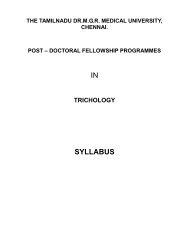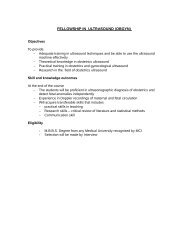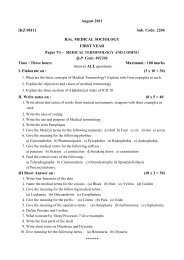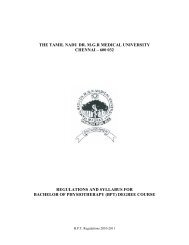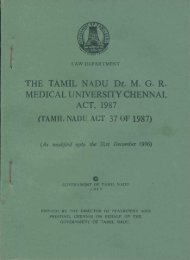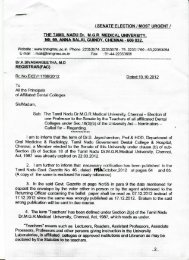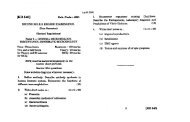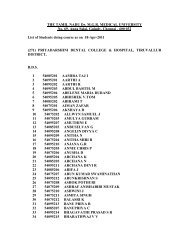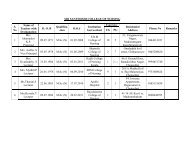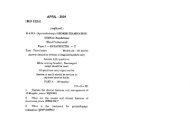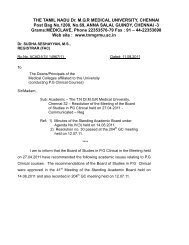Bariatric Surgery - Tamil Nadu Dr. M G R Medical University
Bariatric Surgery - Tamil Nadu Dr. M G R Medical University
Bariatric Surgery - Tamil Nadu Dr. M G R Medical University
Create successful ePaper yourself
Turn your PDF publications into a flip-book with our unique Google optimized e-Paper software.
THE TAMILNADU DR. M.G.R. MEDICAL UNIVERSITY,<br />
CHENNAI<br />
POST – DOCTORAL FELLOWSHIP PROGRAMMES<br />
IN<br />
BARIATRIC SURGERY<br />
SYLLABUS
POST – DOCTORAL FELLOWSHIP PROGRAMMES<br />
IN<br />
BARIATRIC SURGERY<br />
SYLLABUS<br />
INTRODUCTION :<br />
With Obesity and its associated comorbidities has risen tremendously in<br />
India in the recent years with India being the capital for type 2 diabetes in the world. <strong>Bariatric</strong><br />
surgery also called the Obesity surgery has gained popularity in the treatment of Morbid Obesity<br />
and also treatment of its associated comorbidities. But its limited by lack of enough number of<br />
surgeons trained in performing this kind of procedures. Also, there’s at present no recognized<br />
training program in our country for this kind of surgeries. This necessitates interested surgeons<br />
to travel out of the country for such fellowships. Also, for such training to happen, a<br />
multidisciplinary team approach including surgeons, life style therapists, nutritionists,<br />
psychologists etc for a holistic care.<br />
TRAINING OF MINIMAL ACCESS BARIATRIC SURGERY DEFINITION :<br />
Fellows in <strong>Bariatric</strong> <strong>Surgery</strong> will be fully qualified surgeons recognized by<br />
the <strong>Medical</strong> Council of India and/or National Board of Examinations with adequate<br />
experience in Minimal access surgery .The development of such educational programs<br />
will adequately prepare surgeons in the management of Obesity patients and provide scientific<br />
care.
AIM OF THE TRAINING :<br />
Minimal Access <strong>Bariatric</strong> <strong>Surgery</strong> provides significant benefit to the<br />
patients in terms of weight loss, resolution of obesity related co-morbidities like type 2 diabete,<br />
hypertension, dyslipidemis, knee pains, obstructive sleep apnea etc Currently there is lack<br />
of well structured and adequate educational programs in bariatric surgery. This<br />
programme aims to adequately prepare a surgeon to meet the requirements and need in<br />
managing an obese patient for bariatric surgery. Gynecologist in the Art of minimal access<br />
surgery and correct the imbalance between the requirements and availability in the society.<br />
OBJECTIVES OF THE TRAINING :<br />
To train a specialist to be capable of<br />
A. Understanding and performing <strong>Bariatric</strong> surgery<br />
B. Making <strong>Bariatric</strong> an essential part of Minimal Access & General <strong>Surgery</strong><br />
C. Teaching, research and auditing in <strong>Bariatric</strong> <strong>Surgery</strong><br />
D. Co-ordinating and promoting collaboration in organizing the services<br />
E. Providing leadership in developing research within the specialty<br />
ORGANIZATION OF TRAINING:<br />
A. Training programs in bariatric surgery should be in a multidisciplinary<br />
centre of minimally invasive surgery and should be organized by a qualified, accredited team of<br />
trained specialists<br />
B. The Centre should use the guidelines and protocols of national and<br />
international professional bodies which are reviewed at regular intervals.
THE MEANS OF TRAINING :<br />
Entry requirements :-<br />
• MS (General <strong>Surgery</strong>) / DNB(general <strong>Surgery</strong>) from an institute or medical<br />
college<br />
recognized by medical council of India/National board of examinations<br />
1. The trainees should participate in all relevant activities of the training unit<br />
such as the care of Out -Patients and In -Patients, on call duties during both<br />
day and night, also participating in educational activities, including the teaching of<br />
other health professionals. Participation in audit and clinical or basic research is<br />
essential.<br />
2. The duration of <strong>Bariatric</strong> surgery surgery training should be a Minimum of One<br />
Year approved programme and should<br />
aspects.<br />
3.Educational tools<br />
cover the clinical and research<br />
• Good text books on <strong>Bariatric</strong> surgery written by leading and experienced Authors<br />
• Video tapes /CD ROMS<br />
• Simulators for Endo - Training<br />
• Box trainers to master the skills<br />
• Endo trainer rooms with adequate space and good air-conditioning facility to work<br />
long hours in the simulators so the trainee can avoid fatigue.<br />
• Endo-cameras mounted on a special stand with the monitors<br />
• Special hand instruments to learn the hand and eye co-ordination<br />
• To learn depth perception<br />
• To learn tactile sensations<br />
4. The training should be structured throughout with clearly defined targets to be<br />
met after specified intervals.<br />
An education plan should be drawn up in<br />
consultation with the trainees at the beginning of each attachment and<br />
progress should be monitored regularly, by means of log book.<br />
5 Animal laboratory as and when necessary
INFRASTRUCTURE REQUIREMENTS:<br />
Dedicated <strong>Bariatric</strong> department of more than 1000 sq feet , as handling bariatric<br />
patients has sensitivity issues encompassing the <strong>Bariatric</strong> co-ordinator,Nutritionist<br />
and the <strong>Bariatric</strong> surgeon<br />
The Out patient furniture should be equipped to withhold the weight of the heavy<br />
patients with the weight capacities marked clearly<br />
The Shifting equipments(wheel chair, stretchers) etc should be capable of handling<br />
the heavy patients<br />
The OT tables are should be equipped to bear weights upto 300 kg<br />
TEACHING FACULTY EXPERIENCE:<br />
Minimum 3 yrs experience in the field of Bariatrc surgery More than 250 cases<br />
performed Full member of the Obesity <strong>Surgery</strong> Society of India(OSSI) Should have<br />
atleast 2 publications in the field of <strong>Bariatric</strong> surgery in pubmed indexed journals.<br />
TRAINING MODEL:<br />
3 months of wet lab and assisting cases<br />
With experience of 50 cases of assisting – will get to operate individually<br />
ASSESMENT OF TRAINING :-<br />
Each student is evaluated every month by programme Coordinator; should<br />
have operated atleast 20 cases individually<br />
COURSE EVALUATION:-<br />
The trainee gets the opportunity to evaluate the course.<br />
LOG BOOKS :-<br />
The log books are to be submitted for monthly evaluation of the progress<br />
and to evaluate the learning curve.
EXIT EXAMS :-<br />
The degree is awarded after a final exit examination, at the end of one year<br />
training period.<br />
TRAINING PROGRAMME SYLLABUS:-<br />
A. General Principles :<br />
1. Equipment set up and trouble shooting<br />
2. Patient preparation<br />
3. Anesthesia and Monitoring<br />
4. Access to abdomen<br />
5. Creating pneumoperitoneum<br />
6. Abdominal wall lift devices<br />
7. Principles of Endoscopic haemostasis<br />
8. Principles of Electosurgery<br />
9. Principles of <strong>Bariatric</strong> <strong>Surgery</strong><br />
10. Post operative follow up and management<br />
COURSE OBJECTIVES :-<br />
A. To learn about specialized endoscopic equipments and instrumentation.<br />
B. To understand and learn the principles of Minimal Access <strong>Bariatric</strong> <strong>Surgery</strong><br />
C. Gain extertise in surgical management of <strong>Bariatric</strong> <strong>Surgery</strong><br />
D. Diagnosing and management of intraoperative and postoperative<br />
complications<br />
E. Understand the principles of preoperative evaluation and selection of<br />
patients<br />
F. Postoperative care pathways<br />
G. Sterilization and maintenance of instruments and video equipments.<br />
H. Documentation, storage data and presentation.<br />
I. Anesthesia in laparoscopic surgery.
J. Trouble shooting in MAS.<br />
K. Electro surgery and other newer energy sources.<br />
L. Basic and advanced skills in Endo-knotting and tracorporeal suturing<br />
techniques.<br />
SETTING UP OF A LAPAROSCOPIC UNIT :-<br />
A. ROOM LAYOUT AND EQUIPMENT POSITION :<br />
• General considerations include the size of operating room space,<br />
location of doors, outlets for electrical and anesthetic equipments.<br />
• To determine the optimum position and orientation for the monitor<br />
placement.<br />
• Small operating rooms will require diagonal placement of the<br />
operating table and proper positioning of laparoscopic accessory<br />
instrumentation around the operating table.<br />
• All equipment check list helps to ensure that all items are available<br />
and minimize delays in MAS.<br />
THE BASIC INSTRUMENTS NEEDED FOR SETTING UP THE UNIT IS AS<br />
FOLLOWS :-<br />
1. Electrical table adequate weight capacity with leg separation facility and<br />
Lithotomy facilities.<br />
2. Quality video monitors<br />
3. Suction and irrigation apparatus.<br />
4. Electrosurgical unit with proper grounding.<br />
5. Pad equipped with current monitoring system.<br />
6. Cart to house the laparoscopic equipments or pendents.<br />
7.Light sources (Halogen or Xenon).
8. Electronic insufflator or Pneumoflator.<br />
9. Fibro-optic cable.<br />
10. Camera Systems<br />
1. Single chip camera system<br />
(or)<br />
2. Three chip camera system<br />
(or)<br />
3. High definition camera systems<br />
11. Video recorder for Data (or) computer picture Capturing systems connected to the<br />
monitors<br />
or camera consol.<br />
12. Colour printer for documentation.<br />
13. CO2 Cylinders<br />
14. Endoscopic accessory instruments for basic and advanced procedures<br />
15. Intrumentation (regular / long)<br />
1. Atraumatic graspers<br />
2. Locking toothed and jawed graspers<br />
3. Needle holders<br />
4. Dissectors - curved and right angle<br />
5. Bowel grasping forceps<br />
6. Uterine manipulator<br />
7. Tubal perturbation cannula
8. Babcock clamp<br />
9. Veress needle<br />
10. Trocars - 5mm and 10 mm<br />
11. Metzenbaum scissors and Straight scissors<br />
12. Hook with diathermy attachment (L-Shaped)<br />
13. Fan retractors - 10 mm and 5mm<br />
14. Specialized retractors (optional )<br />
15. Vessel Sealing Systems:-<br />
Monopolar electrocautery dissection tools. Bipolar dissection tools<br />
Ultrasonically activated scalpel (optional) Computer controlled diathermy (Eg: LIGASURE)<br />
(optional) Basket containing<br />
• Clip appliers<br />
• Endoloops<br />
• Endoscopic suture materials<br />
• Extra trocars<br />
And open surgical instruments (Conventional surgery) for emergency conversion<br />
to open from laparoscopy, should be kept ready and separate from other Lap. Instruments.<br />
essential.<br />
A back up UPS for lap equipments for uninterrupted surgery in very
TROUBLE SHOOTING :<br />
Endoscopic procedures are inherently complex.<br />
The operative surgeon must learn sufficiently about all equipments which can trouble shoot<br />
and to solve it. Common problems to be learnt are:<br />
1. Cause of Poor insufflations<br />
2. Reason for excessive pressure for insufflation<br />
3. Reasons for inadequate lighting<br />
4. Reasons for too bright lighting<br />
5. Reasons for loss of picture on monitors<br />
6. Reasons for poor quality pictures /fogging / haze<br />
7. Reasons for flickering electrical interference<br />
8. Reasons for inadequate cauterization/inadequate irrigation and suction<br />
PREOPERATIVE EVALUATION :<br />
1.Before surgery, evaluation by qualified anesthetist is mandatory. This should include:<br />
Systems affected by Pneumoperitoneum; -<br />
• Air way<br />
• Respiratory system<br />
• Cardiovascular System<br />
Other Relevant systems<br />
• Central nervous system<br />
• Endocrine system<br />
• Gastrointestinal system
Other relevant History<br />
• Post anesthetic experience of the patient<br />
• Post anesthetic family History of the patient<br />
• Allergies to local anesthetics of the patient<br />
• Medications taken in the past.<br />
1.Monitoring and safety considerations which should include :<br />
1.Breath sounds (Precardial or esophageal stethoscope)<br />
2.Electrocardiogram (continuous)<br />
3.Blood pressure, pulse (continuous, non invasive)<br />
4.Continuous oxygen saturation (Pulse oximeter)<br />
5.Expired carbon dioxide (Capnograph)<br />
6.Temperature gauge<br />
7.Ventilator and additional monitors (optional)<br />
1. Fire prevention is a crucial safety consideration. The operating room is an<br />
oxygen rich environment. The ends of the fibro optic cables become<br />
extremely hot and can ignite drapes. Hence fire extinguisher should be<br />
placed just outside the laparoscopic theatre.<br />
ADMINISTRATION :-<br />
1. Research and audit :-<br />
Setting up the Endoscopic surgery unit, quality control and<br />
assurance, creating protocol for management and organizing and coordinating<br />
of clinical meetings. Counseling of the patients for <strong>Bariatric</strong> surgery, implications, approach<br />
and other complications and getting proper consent for conversion to open if need be .<br />
Module In <strong>Bariatric</strong> <strong>Surgery</strong>:<br />
1. Diagnostic Laparoscopy<br />
2. Laparoscopic Gastric banding<br />
3. Laparoscopic Sleeve Gastrectomy<br />
4. Laparoscopic Roux en Y gastric bypass<br />
5. Laparoscopic Duodenojejunal bypass
6. Laparoscopic Ileal Interposition<br />
7. Revisional <strong>Bariatric</strong> surgery<br />
The academic activities of the program in the hospital should include:-<br />
1. Regular academic sessions<br />
2. Case discussion and seminars<br />
3. Paper presentation<br />
4. Audit/ Project/Research<br />
5. Thesis<br />
6. Conferences / CME’s / Live workshops<br />
• Fine tuning skills in the purpose built animal (wet) laboratory<br />
• The programme is organized to have maximum “Hands-on” practice<br />
sessions in the “Purpose Built” animal laboratory.<br />
• Lecture hall for CME, conference and live workshop transmission with<br />
good acoustics.<br />
WET LAB<br />
The live animal lab should be attached to the hospital campus which should have the following:<br />
1. Preferably air conditioned<br />
2. A regular tilting table<br />
3. A cart for keeping the following equipments<br />
a. Camera<br />
b. Light source<br />
c. Fibro optic cables<br />
d. Diathermy should be placed separately in another trolley to avoid<br />
electrical disturbances.<br />
e. Suction /Irrigation Apparatus<br />
f. CO 2 cylinders
g. CO 2 insufflators.<br />
h. Mask anesthesia Equipments (Basic Boyle’s) for animal anesthesia<br />
i. Pre-Medication chamber for animals<br />
j. <strong>Dr</strong>ugs /Anesthetic agents<br />
k. Post surgery - Recovery area<br />
l. IV Fluid stands<br />
m. Monitors Helper’s for washing the hand instruments<br />
n. Disinfectants<br />
o. A qualified Vet. Anesthetist / Vet. Surgeon should be included for the<br />
programme.<br />
TO SUM UP<br />
Advances in Minimal Access <strong>Surgery</strong> has opened new paradigms in surgery,<br />
which includes surgical treatment of Obesity and its related comorbidities like type 2 diabetes<br />
etc. This is a fascinating frontier of medical science. Butmanagement of these patients<br />
requires considerable technical expertise , good infrastructure and thorough understanding of<br />
patients. Therefore with the rapidly increasing need for learning <strong>Bariatric</strong> surgery, it has<br />
become imperative to ensure safety and safe guard against possible mishaps. The need of the<br />
hour is a properly structured, thorough, logical and effective training programme to train the<br />
specialists in this ever expanding field and to ensure high standards of quality.<br />
RECOMMENDED READINGS :-<br />
1. Minimally Invasive <strong>Bariatric</strong> <strong>Surgery</strong><br />
-Philip Shauer<br />
2. <strong>Bariatric</strong> <strong>Surgery</strong>: A Primer for Your <strong>Medical</strong> Practice<br />
-Francis A. Farraye MD<br />
3. <strong>Bariatric</strong> <strong>Surgery</strong>, An Issue of Surgical Clinics, 1e (The Clinics: <strong>Surgery</strong>)<br />
-Ronald F. Martin MD<br />
4. <strong>Bariatric</strong> <strong>Surgery</strong> & Weight Management (A Cleveland Clinic Guide) (Cleveland Clinic<br />
Guides)<br />
-P. R. Schauer



